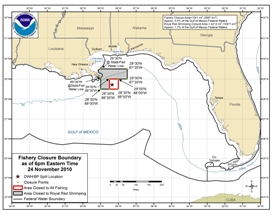|
NOAA Closes 4,200 Square Miles of Gulf Waters to Royal Red Shrimping
November 24, 2010
Area closed to Royal Red Shrimping effective November 24, 2010.
 Today, out of an abundance of caution, NOAA has closed 4,213 square miles of Gulf of Mexico federal waters off Louisiana, Mississippi, and Alabama to royal red shrimping. The precautionary measure was taken after a commercial shrimper, having hauled in his catch of the deep water shrimp, discovered tar balls in his net.
Today, out of an abundance of caution, NOAA has closed 4,213 square miles of Gulf of Mexico federal waters off Louisiana, Mississippi, and Alabama to royal red shrimping. The precautionary measure was taken after a commercial shrimper, having hauled in his catch of the deep water shrimp, discovered tar balls in his net.
Fishing for royal red shrimp is conducted by pulling fishing nets across the bottom of the ocean floor. The tar balls found in the catch may have been entrained in the net as it was dragged along the seafloor.
Other fishing at shallower depths in this area has not turned up any tar balls and is thus not impacted by this closure. The fisherman who reported this catch had trawled for brown shrimp in shallow waters in a different portion of the area to be closed earlier in the day without seeing tar balls.
Following the report of tar balls, NOAA was in contact with shrimpers involved in royal red shrimping in this area. Only a handful of the approximately 250 permitted royal red shrimp fishermen are currently active in the fishery. The tar balls are being analyzed by the U.S. Coast Guard to determine if they are from the Deepwater Horizon/BP spill.
This decision was made in consultation with the U.S. Food and Drug Administration. The closure becomes effective at 6 p.m. EST and does not apply to any state waters.
“We are taking this situation seriously. This fishery is the only trawl fishery that operates at the deep depths where the tar balls were found and we have not received reports of any other gear or fishery interactions with tar balls.” said Roy Crabtree, assistant NOAA administrator for NOAA’s Fisheries Service southeast region. “Our primary concerns are public safety and ensuring the integrity of the Gulf’s seafood supply.
Royal red shrimp are caught in Gulf waters deeper than 600 feet and are the only species targeted with trawls at these depths. The more common Gulf shrimp species are brown, white and pink shrimp and are caught in waters less than 300 feet deep. The agency has received no reports of tar balls from fishermen that target other species in that area. Fishing for other shellfish and finfish species within this area is still allowed.
These waters were closed to all commercial and recreational fishing earlier this summer because of the Deepwater Horizon/BP oil spill and were reopened to all fishing on November 15 after hundreds of seafood specimens sampled from the area, including royal red shrimp, passed both sensory and chemical testing. Additionally, no oil was observed in the area for a period of 30 days prior to the reopening.
NOAA and FDA are continuing to work together to sample seafood from inside and outside the closure, and are continuing market-based sampling of seafood processing plants and dockside sampling. NOAA is also sending vessels to the area to re-sample for royal red shrimp. The agency will reopen this area after determining there is no seafood safety concern. NOAA will conduct extensive sampling in the area, subjecting specimens to sensory and chemical analysis, including the recently approved chemical test for dispersants, in accordance with the rigorous re-opening protocol agreed to by NOAA, the FDA and the Gulf states.
An area covering 1,041 square miles immediately surrounding the Deepwater Horizon wellhead still remains closed to all commercial and recreational fishing. The fishing area closure was first instituted on May 2, at which time it covered about 3 percent (6,817 square miles) of Gulf waters around the wellhead. As oil continued to spill from the wellhead, the area grew in size, peaking at 37 percent (88,522 square miles) of Gulf waters on June 2.
NOAA has a number of methods for the public to obtain information or be notified when there is a change to the closed area:
* Sign up to receive Southeast Fishery Bulletins by email at SERO.Communications.Comments@noaa.gov
* Call 1-800-627-NOAA (1-800-627-6622) to hear a recording of the current coordinates (message in English, Vietnamese, and Spanish – coordinates in English)
* Listen to NOAA Weather Radio for messages about the closure
* Follow us on Twitter: @usnoaagov to get a tweet when the closed area changes
NOAA’s mission is to understand and predict changes in the Earth's environment, from the depths of the ocean to the surface of the sun, and to conserve and manage our coastal and marine resources. Find us on Facebook.
TOP
|